Attached is our App prototype mock up
Author: Graciela Hasbun
Business Canvas
Story Telling Canvas – Final Presentation
Subject- What is the story about?
- Our ideation process trying to come up with a solution for transportation issues for low income patients in SJHS
Goal- What do you want to achieve with this story
- Present a viable and suitable solution and prototype
Audience
- SJHS administration and offices of community outreach
Before – what does your audience think, feel , know, want, before they have experienced your story
- Gallery Day
- details on the problem
- About the class
- Failed solutions
- Want
- solution
- cost effective
- no liability or legal issues
- not alot of required man power or capital
set the scene – what do you need to introduce?
- process used
- ethnography
- guiding principles
- trends
- immersions
- past failed attempts
make your point
- solutions
- how it fits needs
- how its integrated into existing system
- babysitting
- rewards
conclusion
- who it helps
- how to move forward
- cost
- reduction of missed and skipped appointments
After
- a sense of hope
- desire to look into it more
- desire to pass along ideas
- excitement about future
Workarounds – Amanda
First workaround: I used a clip meant to keep chips fresh on my toothpaste tube to push the toothpaste down.
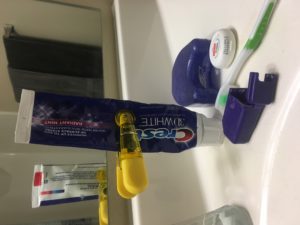
Second workaround: I made a makeshift fruit basket out of an empty wine bottle and the netting clementines come in so I can more easily see the fruit I have.

Third workaround: I noticed my friend was using a blanket to cover her window to block the sun in the morning.
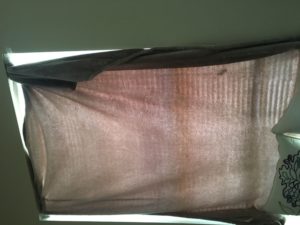
Prototype Plan
Idea 1: Mobile App/ Scheduling System
Summary of Idea: Idea 1 consists of a system utilizing both an app/website as well as a receptionist/ transportation coordinator. The system will begin when a patient first schedules an appointment. The receptionist will ask if they have a Smartphone. If yes, the receptionist will ask if they would prefer to get text message and use an app or to receive a phone call. If no, it will automatically be a phone call. A few days before the appointment there will be a confirmation text or call. With the text, the patient will confirm the appointment and answer if they need transportation help. If yes, it will direct them to a webpage or an app in which they can enter all of the relevant information such as appointment time, pickup location, insurance information, budget, number of passengers, etc. The app will put out all of the relevant transportation options including cost and duration of trip and the patient will select and schedule the method of their choice. If the patient does not have a smartphone or does not choose to use the app, a phone call will be made and a receptionist or transportation coordinator will enter the information into the system and book the transportation. Patients will also receive a push notification or automated phone call the morning of their appointment reminding them of their pickup time and method of transportation.
Consider the Setting: We believe that it would be beneficial to first show our rough idea of our prototype to experts and staff such as Michelle, Geoff, Receptionists and Care Coordinators. Given that this is a system that would be used by SJHS and their staff, the input from the people running the technology would be the most beneficial in helping us modify and tweak our prototype to best fit SJHS needs. We would also want to talk to someone in the IT department about systems integration. After the app is created, we would then test it on users.
Define What to Test: We would test the ability for the app to effectively schedule and book transportation services. We would also test to see if the SJHS staff is able to use the system and integrate it into their current system and daily work. In doing so, we will be able to discover the effectiveness of our overall prototype system. It is important for us to determine if this system could work with the SJHS administrative staff before going any further because if it cannot work with the administrators then it will not be able to work for the patients themselves.
Define Feedback Activities: Our first order of business is to get into contact with the stakeholders that we have already interviewed. Feedback from stakeholders such as Geoff would be extremely useful because these people have already worked to solve the current transportation problems. Furthermore, talking with Michelle is crucial because she will be able to tell us whether or not our prototype would work on a large scale with the many offices of the SJHS. Lastly, we must meet with more receptionists and volunteers because they will be the ones who would actually be using our service in their day-to-day work. In talking with all of these stakeholders, we will be able to make changes to our idea, and ultimately come up with the best possible solution to the transportation problems at hand.
Idea 2: Uber Partnership
Summary of Idea:
Idea 2 involves St. Joseph Health System developing a partnership with Uber. While prices associated with Uber may be a concern, the flexibility and readiness that Uber provides will have enough of a positive impact that SJHS will overcome its current transportation problem. Some barriers to developing such a partnership include billing; while Medicaid patients are covered for transportation in most situations, the amount organizations are reimbursed varies between states. Another issue is the fact that SJHS patients and clients may not have the ability to readily access technology such as smartphones used to request Uber rides. The benefits that having clients use Uber affords healthcare organizations outweighs these barriers, and there are even ways to overcome these barriers. At the following URL, https://tinyurl.com/n4rthzp, a healthcare expert discusses the various ways organizations have undertaken partnerships with Uber and Lyft to overcome problems with transportation. There is an opportunity for SJHS to give patients access to requesting Ubers on their website or through phone calls with receptionists. Our team will conduct further research into the intricacies of billing regulations and any other liabilities or other issues associated with SJHS partnering with a transportation company such as Uber.
Consider the Setting: We are not innovating a product necessarily, but rather creating a new relationship between SJHS and Uber. SJHS employees will have a general awareness of Uber’s technology, yet we could certainly role play as SJHS clients looking for a ride and reveal how efficient Uber is. We feel it would be beneficial to pitch our idea to SJHS at one of their facilities. With access to multiple departments, we could discuss the complexities of billing with SJHS employees who would be involved. We could also have a few SJHS volunteers join the meeting, so they could gain a better understanding of what it would look like assisting people arriving at the hospital in Ubers.
Define What to Test : We need to test our idea in two ways. First, we need to assess the likelihood of SJHS patients using Uber after a partnership had been developed. Through our research we are confident that clients would use Uber. Secondly, we need to test how SJHS employees adjust to a partnership with Uber. Employees in charge of billing with Medicaid and Medicare patients will take on a slightly different role since adjustments would need to be made when billing for patients who used Uber.
Define Feedback Activities: We will assess feedback from patients’ point of view and SJHS employees’ perspective. We will plan to visit different SJHS facilities and ask patients whether they used Uber. If they answer yes, we will ask how they felt about the experience. We will also develop a survey to be passed out to patients, possibly in the Emergency Room or in the lobbies of different facilities. Finally, we will conduct several meetings with SJHS employees throughout the next few months after establishing a partnership with Uber. This will allow us to assess the functionality of the new partnership from SJHS’s perspective.
Idea 3: SHJS Shuttle Service
Summary of Idea: Idea 3 involves SJHS purchasing at least two vans to provide patients complimentary rides to and from their appointment in specific drop-off/ pick-up zones. To request a ride, patients would either call or visit the hospital website. Patients would be required to give their name, location, and number of people they are riding with. Shuttles would go to designated drop-off/pick-up locations based on the database of SJHS’s clients in the Mishawaka area. Approved volunteers could drive the shuttles and be in constant communication with a dispatcher for every drop-off and pick-up.
Consider the Setting: This idea would best be shared in a meeting with team members, Michelle, Geoff and SJHS staff present. It would be best to go over logistics and the big picture plan with Geoff and Michelle who can add valuable input with their expertise and experience. Once the idea is approved by SJHS, we would meet with the IT department to go over updating their website so that users can request rides online.
Define What to Test: Would clients use shuttle service? What kinds of clients would use it? How do we make the service convenient to patients and resource efficient to the organization? How do we approve volunteer drivers? Where will the startup money come from? Does SJHS have a flexible budget that will enable this program to work?
Define Feedback Activities:
We would start out by administering a survey to see how many patients are interested in utilizing this service. In doing so, we will be able to identify whether or not our idea is feasible in the first place. From a financial aspect, we will need to meet with SJHS administrators that deal specifically with managing system budgets. This will allow us to determine if our idea is financially doable and if there is any room in the budget to fund the start of the program.
Design Criteria
| Guiding Design Principles | |
| Design Goal |
|
| User Perceptions |
|
| Problems, Needs, Opportunities |
|
| Functional Attributes |
|
| Constraints |
|
Guiding Principles
Guiding Principle 1: Make Transportation Resources Known to Me and Easy to Understand
Insights:
| Improve Marketing | Improve Simplicity | Make Resources known to SJHS Staff and Patients | Make Resources Bilingual |
“There is not enough marketing for the resources available and when people find they have a problem they often don’t know where to look for a solution”
On Lack of Technology to research resources :“Most of my clients do not even have cell phones and if they do they are flip phones” – Kaley Kubiac, Transportation Coordinator Riverbend. |
Due to Medicaid restrictions, A lot of the burden to schedule transportation sits on the patient who might be unable to do so or not know how to do it.
|
“ People and staff in house don’t know about the resources. There is a communication gap”
|
“Some inefficiencies arise when there is a language barrier between the patients and the center’s workers.”
|
Guiding Principle 2 : Make Transportation Services Flexible
Insights:
Make it flexible as appointments often run behind schedule |
Make it flexible in case I have to bring children with me |
Make it flexible in case I have to pick up medication or other necessities on the way home |
Have late night and weekend hours |
“Scheduling one single ride might take 7 separate phone calls and conversations”
|
“I usually walk, which is more difficult carrying 3 kids and I’m 9-months pregnant.”
“All my kids go to different schools…every day is different.”
|
“While REAL Services does transport patients, our transportation services operate within a very specific time frame which leaves some patients without transportation help.”
|
In a phone interview with Michelle Peters, Director of Community Health and Wellbeing for St Joseph’s Health Systems, she mentioned that South Bend transpo lacks in weekend and late night routes. The current routes also do not go to all of the SJHS facilities. |
Guiding Principle 3 : Make it time efficient and Cost Efficient
| Make it cost efficient for Patient | Make it cost efficient for Organization | Make it as time efficient as possible | |
| “Uber requires a credit card. I don’t have a credit card”
-Kate, client at Mishawaka Medical Center -Laura, client at SJHS Mishawaka Medical Center’s Pediatrics |
“Patient no-shows can be very costly..up to $300”
–Geoff Zimpelman, Population Health -Rob, SJHS Volunteer |
“I’ve been waiting one hour for the Medicaid shuttle”
-Kate, client at Mishawaka Medical Center -Geoff Zimpelman, Population Health |
Guiding Principle 4 : Create continuity for patient transportation within all medical offices and facilities
Insights:
| Improve communication between all offices | Find one company, like uber, that will be certified by medicaid throughout all regions | Lessen criteria to increase amount of people who can utilize services |
| “Nothing is centralized. Each clinic and office does different things and they don’t work together on things such as transportation” –Obi Madukoma, Care Coordinator Population Health |
“Medicaid will cover transportation costs for its patients, but this can get complicated because only certain cab companies are certified to pick up patients. Depending on where you live, there may not be a viable cab company to use.” -Ranae, Receptionist at Family Medical Office |
“Various organizations will provide transportation for patients, but each organization will only deal with people who meet specific criteria.” -Geoff Zimpelman, Population Health |
Guiding Principle 5 : Solution needs to work on a large scale and handle large influx of volume
Insights:
| Use Resources Efficiently | Standardize Method of Transportation | Frequent and Flexible |
| “With many different services currently being offered, it is important for SJHS to make sure that certain resources are not being unnecessarily duplicated.”
|
“A transportation service that provides ‘door-to-door’ transportation would work best to accommodate all kinds of patients with varying levels of functionality.”
|
“Transportation must be able to accommodate different patient’s schedules and availability for doctor appointments.” –
|
Ethnographic Research – Analogous Immersion
Date of Immersion: 3/2/17
Type: Analogous Immeresion
Participants: Amanda Berusch, Sarah Reihl, Matthew McCormick, Paul Cepak, Yuwei Tu, and Parker Mathes
Event: Homeless System Simulation
Event Description: The Homeless System Simulation was created by the National Alliance to End Homelessness in order to better understand the issue of homelessness. Using the tools of the game/simulation, players are able to understand the public assistance system. Throughout the game marbles are placed into different services and the point is to have the smallest score. At the end, points are added when beads are left in the unsheltered homelessness and emergency housing categories, and points are subtracted when beads are left in the market housing, rapid rehousing, and permanent supportive housing categories.
Key Takeaways:
Funding for Public Assistance
By playing the game, we realized the limitation of government funded assistance programs and resources. Since there is only a certain amount of marbles, only so much can be placed into the most important resources. Although permanent supportive is one of the most important resources to reduce homelessness, other services such as emergency shelters and outreach are necessary to keep those who still struggle with homelessness safe. Therefore, we knew that we wanted to increase the number of marbles in permanent housing and rapid re-housing, but the ability to increase this type of housing would mean there would be less emergency shelters and transitional housing. We would like to decrease the funding for the latter, but that is contingent on the homeless population’s willingness to use other public resources such as counseling to permanently get out of their situation.
We were able to conclude that public assistance is very dependent on the resources made available by the local government. For example, if the city of South Bend pushes the publicly funded counseling and welfare services, the homeless population may be more likely to take advantage of them and be in a better position to qualify for permanent housing. If more homeless people qualify for more permanent housing, then the city can put more money towards these resources than emergency shelters.
Patterns
Following Gallery Day, the team stepped back and tried to find patterns between users, our observations, and our ethnographic research. We used these patterns to help us form guiding principles and to formulate our design criteria. The following are pictures of some of the patterns we found.
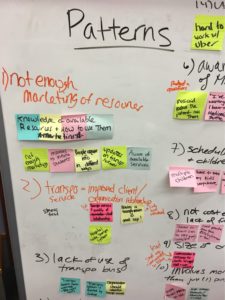
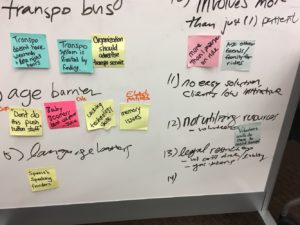
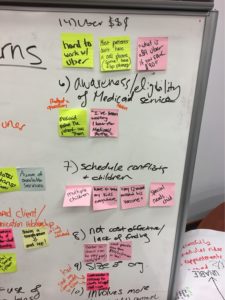
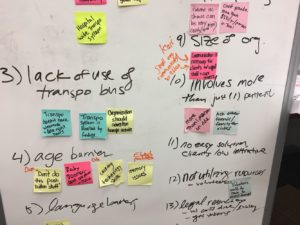
Card Sort Reflection – Amanda
The results of our card sort were not as surprising since we understand that food and shelter tend to be the most important necessities to the homeless population and to those looking to escape homelessness.
However, something we did not take into account is that most of the individuals who participated in the card sort knew about the resources available to them in South Bend, they just simply did not take advantage of them. We did not ask enough questions as to why resources such as Memorial Hospital and Oak Lawn were not popularly were not typically used even though we concluded that mental illness and substance abuse were two big issues in the homelessness issue in South Bend. Both resources provide services such as counseling for mental health and substance abuse, addiction treatment, and child services. Therefore, it may be important to ask and get more information on why these services are underused. Something we didn’t account for was the possibility that the current homeless population or those in danger of homelessness do not have the proper transportation or simply are not aware of how to get to these programs.